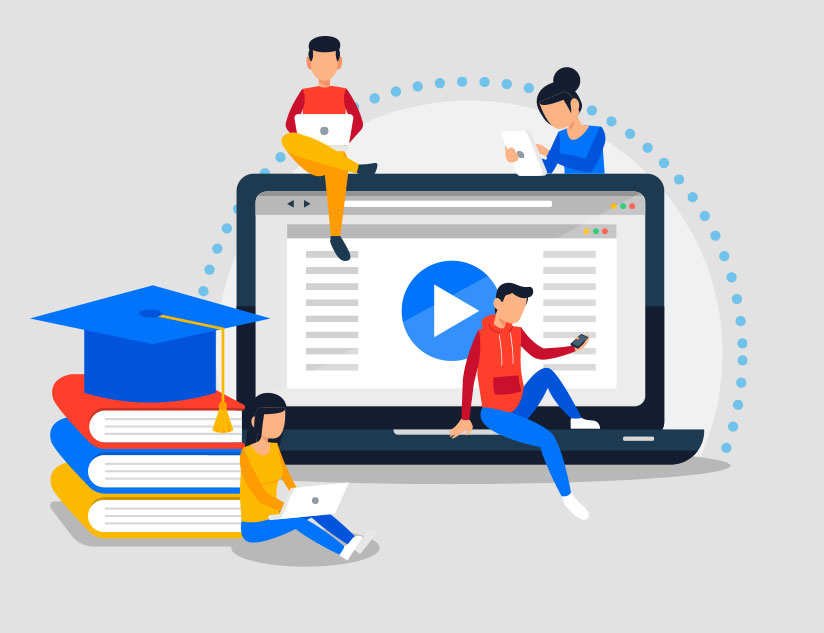Microlearning has emerged as the power-packed solution to addressing the needs of learners in the digital age. Bite-sized learning materials enable students to grasp a concept, acquire a skill, or refresh existing knowledge quickly and easily. It is extremely helpful for higher-ed students and corporate and life-long learners looking for continued education when time has become the least available resource. It helps both in upskilling and reinforcing existing knowledge.
The demand for microlearning materials is forecasted to propel the valuation of this learning methodology to over $4 billion at a CAGR of 17.95% between 2023 and 2024. This opens a massive opportunity for edtech organizations to capitalize on emerging learner needs.
Principles of Microlearning
Microlearning is based on breaking down learning into digestible modules while leveraging multimedia and interactive techniques to bolster learning efficacy with active learner participation. It helps fill knowledge and skill gaps quickly.
Consider a student preparing for a math exam who wants to reinforce Pythagoras’ Theorem. An interactive microlearning module saves time and is more effective than looking through textbooks, long PDFs, or a 6-hour detailed lesson. Similarly, corporate employees have particular learning requirements according to their job role or the task at hand. Access to targeted micro-lessons can significantly expedite knowledge acquisition and translation into action without impacting their productivity.
For instructional designers, the key is brevity. Keep the content concise and focused. However, you can still add links and references to supplementary resources for learners who wish to know more. Short learning modules address all needs, whether it is the short attention span of today’s learners or the proliferation of mobile learning. Microlearning modules leverage gamification, infographics, and interactive modes to keep users engaged throughout the topic. Educators must adopt content-authoring tools that assist in building bite-sized learning material with recommendations, templates, and compliance to expedite the process. Finally, AI-powered smart, immediate feedback helps learners gauge their progress, and educators evaluate the module’s efficacy.
Advantages of Microlearning
Bite-sized learning has transformed education by providing more control to students and allowing continued and lifelong learning to penetrate deeper. This is because:
It’s Flexible
Microlearning allows learners to choose what they want to learn according to their time. Just-in-time learning facilities offer targeted knowledge, making them popular among digital learners.
It’s Retainalble
Bite-sized learning improves retention because focused education to achieve a single goal aligns the content well with the learning outcome. Also, active participation techniques make microlearning more effective than traditional learning, where long modules and the need to accumulate large chunks of information can overwhelm the learner.
It’s Swift
Creating short, snackable content significantly saves educators’ time since they can prepare and assign modules that can easily be reused for revisions or even full-fledged lesson planning and delivery. This can further enhance traditional teaching methods. Microlearning modules are easy to update and modify as well.
It’s Customizable
Micro-learning facilitates personalization by making targeted modules available to align with individual learning paths, which can be challenging to ensure with larger learning modules.
It’s Encouraging
Microlearning promotes flipped and self-driven learning. Accessible, bite-sized learning bolsters learner accountability and encourages ownership to cultivate lifelong and continued education habits. As more and more K-12 learners opt for it, the self-paced learning industry is projected to expand at a CAGR of 8.2% from 2021 to 2026.
Potential Use Cases of Microlearning
Microlearning has the power to fulfill diverse learning needs:
- 97% of employees believe training on the organization’s tools and software is essential during onboarding. A bite-sized approach helps bring new employees up to speed with agility.
- For a business releasing new products at scale, microlearning can help impart on-demand product knowledge to any employee.
- In the age of tightening regulatory oversight across business domains and the continuous evolution of compliance laws, microlessons offer a quick way to apprise all members of an organization at scale.
- Microlearning addresses the increasing demand for upskilling and reskilling employees. It is imperative in digitized and increasingly automated job roles that have changed by 25% in the eight years from 2015 to 2023.
Proven Success
Walmart’s gamified microlearning program, which required only 3 to 5 minutes of employee time, helped reduce safety incidents by 54% across distribution centers. 91% of workers voluntarily participated in the program, which helped boost their safety-related knowledge and awareness by 15% and confidence in materials by 8%. Moreover, 96% of employees could apply the knowledge they acquired to their jobs.
Adopt the Right Approach
While microlearning has its benefits, it does bring certain challenges. Achieving the right level of detail and managing the vast database created are among the top ones, as is maintaining branding consistency. This makes adopting the right content authoring and data management tools critical. Additionally, to meet the needs of digital learners, content needs to be platform-independent, easily accessible, and multilingual. Speak to the experts at MagicBox to elevate your edtech platform’s microlearning design, development, distribution, and delivery processes.














